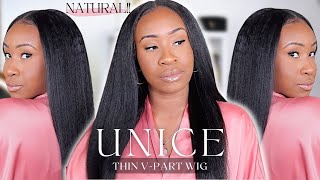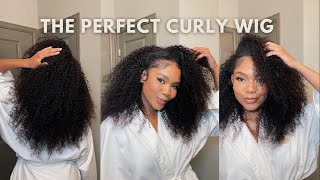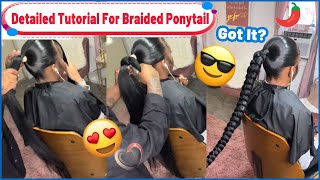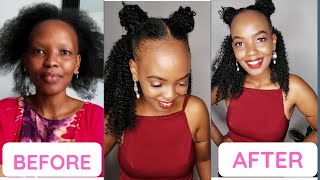6 Tips for a Successful Transition to Natural Hair
 There are two kinds of women out there – those that are willing to big chop, and those who aren’t. I definitely wasn’t willing to big chop when I first began my natural hair journey and wound up transitioning for a year and three months.
There are two kinds of women out there – those that are willing to big chop, and those who aren’t. I definitely wasn’t willing to big chop when I first began my natural hair journey and wound up transitioning for a year and three months.
If you decide that the big chop is not for you, then you wind up going through what’s known as a transitioning period.
Transitioning simply means that you’re growing out your natural hair while still maintaining your relaxed or damaged hair.
Transitioning can seem a little hard at first (at least, I know it was for me) but with these tips your transitioning period should pass without a problem.
Limit heat use
Since the relaxed or heat damaged hair is permanently straight, some of us may think that the easiest way to blend the two textures is to use heat on the natural hair as well. However, using heat can be counterproductive, because too much heat will only damage the new growth as well!
Instead of using heat, try other styles that can blend the two textures. Since the relaxed ends won’t curl on their own (I literally had to learn that from experience) you can do bantu knots and flexi or perm rod sets. Your hair will be more moisturized and you can start practicing your favorite styles for when you’re fully natural.
If you do decide to use heat on your hair, don’t make it an everyday thing and take some precautions. Try stretching your hair beforehand to avoid using a blow dryer*, and ALWAYS use heat protectant*.
Beware of the line of demarcation
The line of demarcation is the area where the relaxed and natural hair meet. It’s very fragile, and hair can snap off at this point for a few reasons. Avoid harsh detangling; try finger detangling instead to gently manage your hair. Don’t pull on your hair too harshly and treat this part of your hair well as you get further into your journey.
Don’t try to care for your relaxed hair more while transitioning. This will only limit the health of your natural hair. Use products for natural hair and don’t fall back into trying to blend natural hair with relaxed. Wash and style your hair in sections so that you aren’t grabbing your hair too harshly, causing the ends to snap off.
 Keep ends tucked away
Keep ends tucked away
Your ends are the oldest part of your hair and can be prone to damage and breakage. Added with the fragile line of demarcation, it’s important to make sure that you care for your transitioning ends.
Doing updos like buns are an excellent way to keep your ends tucked away and healthy during your transition. You can experiment with other styles as you like, but you will notice that by keeping your ends protected you have less breakage, damage, and less split ends. Updos are also a good way to keep your hair out of the way and it hides the fact that your hair is two different textures.
Keep hair moisturized
Moisturizing hair consistently is an important step to keeping it healthy whether you’re transitioning or already natural. Your transitioning period is a good time to figure out your hair regimen and learn what products work for your natural hair.
Begin adding more moisture into your regimen while transitioning. Try deep conditioning* at least once a week, and start sealing your hair after every wash with either the LOC (Liquid. Oil. Cream) or LCO (Liquid. Cream. Oil) method.
Refresh your hair every few days by spritzing it with water and reapplying an oil. Massage oil into your scalp and concentrate it on your ends every time that you moisturize. Also consider adding pre-pooing or oil rinsing to your regimen for extra shiny and moisturized hair.
Consider protective styling
Protective styling (if done correctly) can be the same perfect solution for getting past your transitioning period. Protective styles blend the two textures together and keep your hair tucked away. There are a variety of styles you can try, some examples are below:
-Box Braids
-Senegalese (or Marley) twists
–Weaves*
–Wigs*
-Crochet Braids
Pick the style that works best for you and go with it. If you decide to protective style, you can keep it in for increments of one or two months and you won’t have to deal with that annoying line of demarcation!
Trim Regularly
Although the point of transitioning is so that you don’t have to chop off all of your hair (until you’re ready) you still need to trim your ends regularly. Our ends are the oldest parts of our hair, so they may need a little more maintenance.
Since you’ll be taking more care of your natural hair than the damaged hair, your ends may be more susceptible to split ends, tangling, etc. Figure out a trimming regimen that works for you.
Decide whether you want to trim every few weeks, every few months, etc and decide exactly how much you want to trim each time you do. Just make sure you’re getting rid of that damage! Every trim puts you one step closer to a head of fully natural hair!
Transitioning can seem like a chore if you have no idea what you’re doing, but it doesn’t have to be hard! As long as you keep your hair healthy and moisturized during your transition, you’ll notice that your natural hair will grow rapidly.
Before you know it, your relaxed or heat damaged hair will turn into a full head of curls and you’ll have a regimen that you can keep and add on to when you’re fully natural!




